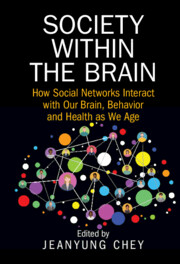Book contents
- Society within the Brain
- Society within the Brain
- Copyright page
- Dedication
- Contents
- Figures
- Tables
- Contributors
- Preface
- Introduction
- Part I Approaches to Society within the Brain
- Part II Society Interacting with Brain, Cognition, and Health in Late Life
- Chapter 5 The Life Course Approach to Cognitive Aging and Dementia
- Chapter 6 Enriched Social Connectedness and Brain Function
- Chapter 7 Psychoneuroimmunology Linking Social Isolation with Cognitive Aging
- Chapter 8 Loneliness and Psychological Health in Late Life
- Part III An Individual’s Cognitive Aging with Others: Key Findings, Issues, and Implications
- Index
- References
Chapter 6 - Enriched Social Connectedness and Brain Function
from Part II - Society Interacting with Brain, Cognition, and Health in Late Life
Published online by Cambridge University Press: 28 September 2023
- Society within the Brain
- Society within the Brain
- Copyright page
- Dedication
- Contents
- Figures
- Tables
- Contributors
- Preface
- Introduction
- Part I Approaches to Society within the Brain
- Part II Society Interacting with Brain, Cognition, and Health in Late Life
- Chapter 5 The Life Course Approach to Cognitive Aging and Dementia
- Chapter 6 Enriched Social Connectedness and Brain Function
- Chapter 7 Psychoneuroimmunology Linking Social Isolation with Cognitive Aging
- Chapter 8 Loneliness and Psychological Health in Late Life
- Part III An Individual’s Cognitive Aging with Others: Key Findings, Issues, and Implications
- Index
- References
Summary
A growing body of evidence suggests a strong link between how individuals maintain an enriched social network and their brain health. Both the quantity and quality of social networks provide abundant social connections. Through persistent social interactions, individuals’ neurocognitive health appears to benefit from cognitively stimulating activity as well as social support. By utilizing various neuroimaging methods, researchers have found that maintaining an enriched social network is likely to lead to better neural functioning that could delay or counter the effects of neuropathological progression in late life. This chapter reviews studies examining the relationship between social network characteristics and neurocognitive health. The studies highlight that social connectedness and brain functioning have reciprocal effects. It also discusses whether larger and cohesively connected social networks lead to a healthier brain and better cognitive function, as well as the moderators of this association.
Keywords
- Type
- Chapter
- Information
- Society within the BrainHow Social Networks Interact with Our Brain, Behavior and Health as We Age, pp. 141 - 161Publisher: Cambridge University PressPrint publication year: 2023

